Wind turbine, wind energy, or wind power are explained along with basic details, types, various applications, advantages, disadvantages etc.
Let’s explore!
Wind Turbine, Wind Energy or Wind Power
Let’s try to understand wind turbine, wind energy, or wind power. The need of the hour is to move the energy and power requirements to renewable sources. This is where the Wind energy or wind power used in the wind turbine comes into play.
Let’s get into,
- Wind energy or wind power
- Wind turbine
Wind Energy or Wind Power
The wind is created by nature due to many reasons,
- Atmospheric temperature difference by the sun,
- The uneven surface of the earth,
- Rotation of the earth,
- Mountains at various locations,
- Sea or other water bodies etc.
Wind energy or wind power is defined as the energy that uses wind to creates electricity. As wind occurs naturally in the earth’s atmosphere, it is a renewable source of energy.
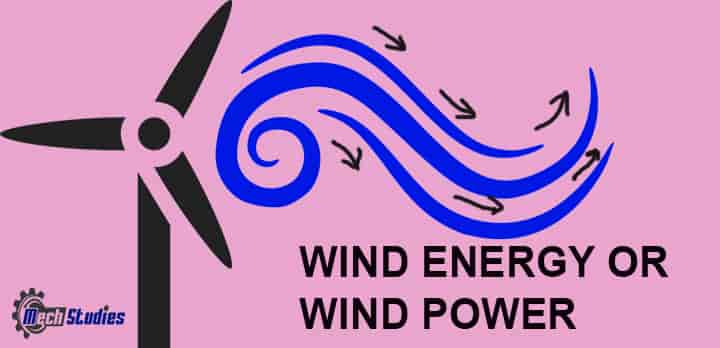
Wind Power is calculated based on the following equation,
P = (1/2) ρAV3
Where,
- P = Wind energy or wind power, watt
- ρ = Density of Air (kg/m3)
- A = Rotor Swept Area (m2)
- V = Velocity of wind (m/s)
There are few characteristics of wind energy,
- Power is proportional to the cube of wind speed, i.e., P ∝ V3. Hence, if speed is increased, wind power will increase drastically.
- Power is proportional to the density of air, i.e., P ∝ ρ. Hence, if the density is increased, wind energy will increase. At lower elevation, air density is more, hence, wind power will be more.
- Power is proportional to the rotor swept area, i.e., P ∝ A. Hence, if the rotor area is more, wind energy will be more.
Check out our ‘MechStudies – The Learning App’ in iOS
& Android
Wind Turbine
The wind turbine is one kind of turbine, which is placed in specific places to generate power, mainly to generate electricity, running small-scale plants as an alternative power source.
- The kinetic energy of the wind is converted into electrical energy in the wind turbine.
- Fossil fuels are on the verge of depletion and the pollution caused due to the burning of fossil fuels is world known.
- There are wide effects of fossil fuel use like global warming, ozone depletion, and a lot more.
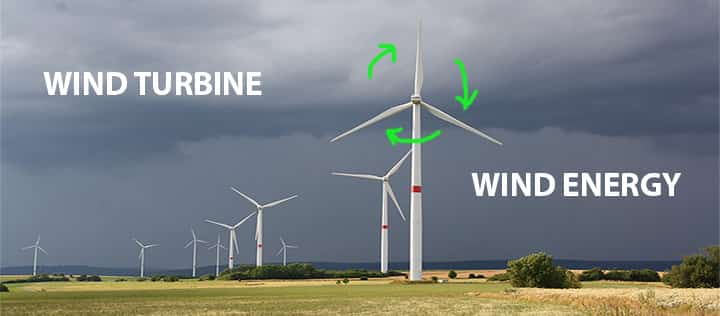
There are some methods used to counter the use of fossil fuels. Renewable sources of energy like solar, tidal, hydro, geothermal, biomass are considered as an alternative.
One of them is Wind energy. So, to generate energy from the wind, the Wind turbine is a necessity.
There are mainly two types of turbine used one horizontal axis and the other is the vertical axis. The classification of the wind turbine is not that much bigger, let’s get into it.
Types of Wind turbine
Wind turbines are classified based on two criteria,
- According to design
- According to size
According to design
- Vertical axis design – These are designed like an egg-beater. It is named after French inventor Darrius.
- Horizontal Axis Design – Most modern wind turbines are horizontal turbines. They are widely used for electricity generation.
According to size
- Small turbines – These are having the capacity of 100 kilowatts mostly used in homes.
- Utility-scale turbines – Starting from 100 kilowatts and it can go up to few megawatts.
So, this is the small types of wind turbines. There are various parts associated with the wind turbines that accommodate their working. Before knowing more about the horizontal axis turbine and vertical axis turbine let’s know more about its components.
Check out our 100% Solved Quiz
Wind Turbine Parts
The major components of the wind turbines are tower, rotor, nacelle, generator, and the base or foundation of the wind turbine.
These are general and major components of the wind turbines,
- Foundation or base
- Tower
- Rotor
- Hub
- Blades
- Nacelle
- Rotor Brakes
- Generator
- YAW motors & brakes
- Sensors
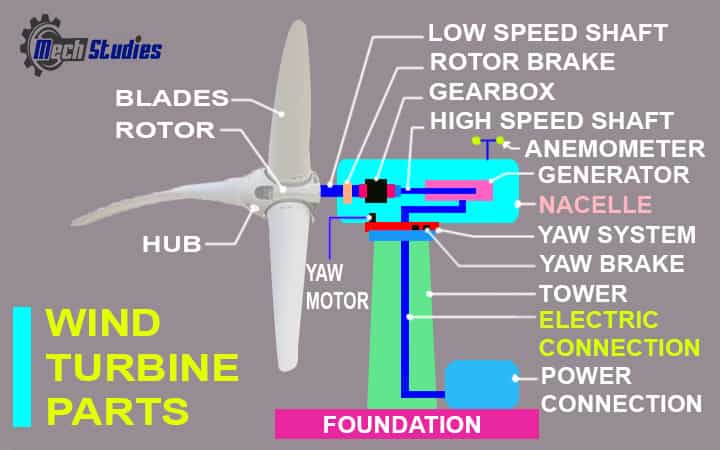
Foundation or base
The foundation or the base of wind turbine is the one on which these turbines are placed. The different methods are employed for the offshore and onshore turbine placements.
- Like for the onshore wind turbines, the foundation is made underground and later covered by the soil.
- The foundation cannot be seen it is heavily constructed with a block of concrete.
- It is constructed such that it should support or hold the turbine structure.
Now for the offshore wind turbines, the foundation or base is constructed underwater. It cannot be seen but also it is built with a strong structure to hold the forces and mass weight of the wind turbine.
Tower
Nowadays most modern turbines tower is round tubular steel with a diameter of 3-4 meter (10-14 feet).
Generally, it has a height of 75-110 meters (250-370 feet).
- The height of the tower is decided according to the size of the turbine used and the location it’s going to be placed.
- The thumb rule for the wind turbine tower is, the height of the tower should be the same as the diameter of the circle of its blades while rotating.
- The taller the turbine is built with the help of the tower more wind will be subjected to the wind turbine, though the wind does not have the same speed at various distances from the ground.
Rotor
The rotor is the one that accommodates the blades on the periphery.
- The rotor is equipped with three rotor blades, they are attached to the hub.
- Though the wind turbine may have 4-5 or any number of blades as per the requirements, but the 3-blade arrangement is most efficient and is widely used.
Hub
The hub holds the turbine blades. The blades are attached to the hub, the hub allows the blades to rotate.
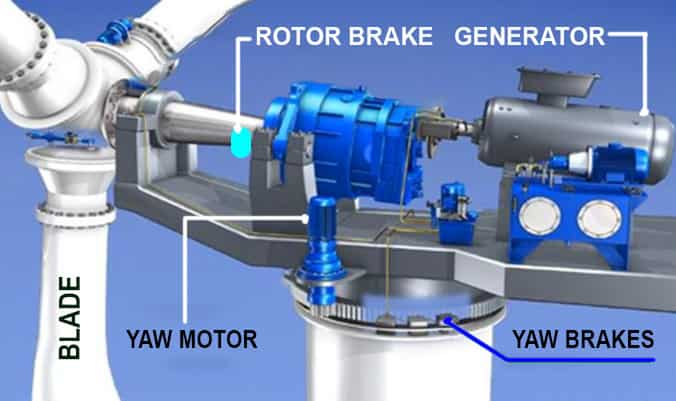
Blades
The blades are hollow and are made of composite material that is light and strong.
- The new advancements are being done to make them larger for getting more power, lighter and stronger.
- The blade motion is known as blade pitch and they can rotate about 90 degrees to its axes.
- The shape of the blades is aerodynamic like the shape of an aeroplane wing.
- They are not totally flat-shaped they twist at roots and the tip.
Nacelle
The nacelle houses the generator of the wind turbines.
- It can be either gear driven or direct drive.
- It includes all the components that are going to be placed at the top.
- All the complicated systems, components are included in the housing.
The gearbox is present in the nacelle it is a major component of wind turbines. The work of the gearbox is it will increase the main shaft speed of approximately 12-25 RPM to the speed required for the generator. That is the reason for calling the generator side shaft the high-speed shaft.
The wind can change its direction and the wind turbine should adjust according to the direction and adjust its orientations. The rotation is known as the yaw motion, the nacelle and the rotor revolve about the tower axis.
Rotor Brakes
Brake is an important part of a wind turbine, in case it needs to be stopped the rotation of the turbine blades, due to the following reasons,
- Maintenance issues,
- If the wind speed exceeds the design speed,
- Any emergency services etc.
Wind turbine brake is placed in associated with low-speed shaft and it can be electrical or mechanical or hydraulic types depending on the applications.
Generator
The generator is the component which converts the mechanical energy received from the rotor to electrical energy. It has same kind of structure as the electric motor.
- The generator can be selected synchronous or asynchronous (induction generator).
- Mostly the induction generator is used.
Sensors
There are various sensors in wind turbines, like,
- Displacement sensors, which continuously monitor the structural stability of the turbine.
- Wind sensors, which continuously monitor the direction of the wind. Normally, an anemometer is used to measure the speed of the wind. Any change in the direction signals to the main control system to change the angle with the help of the yaw motors.
- Temperature sensors, which continuously monitor the overheating.
YAW Motors & Brakes
Wind direction is not fixed, it can be changed based on the season. Hence, it is required t change the facing of the rotor.
- Yaw motor helps to change the facing of the rotor.
- Yaw brake helps to fixed or stop r control the facing.
Now all these are the basic components of the wind turbines. Now let’s know more about the horizontal and vertical axis turbines in brief.
Horizontal Axis Wind Turbine (HAWT)
What is Horizontal Axis Wind Turbine (HAWT)?
The horizontal axis wind turbines are widely used turbines nowadays. They produce the majority of power in today’s world.
- It has a rotor and electrical generator located at the top of the tower.
- They are pointed into the wind.
- The small turbines are pointed into the wind just by the simple wind.
- The large ones are pointed by using the wind sensors equipped with the servo motors for easy and automatic operations.
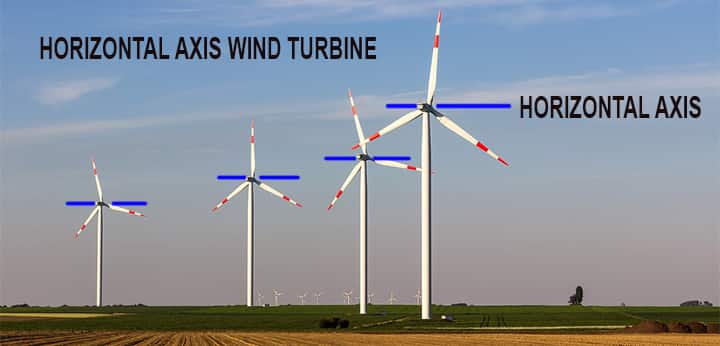
HAWT blades are made stiff it prevents the blades from being pushed into the tower and sometimes they tilt forward into the wind by a small amount of margin.
- As the turbulence is produced behind the tower, turbines are usually pointed upwind of the tower.
- There are downwind turbines also available. But there is a problem with the downwind turbines, it’s because of the turbulence.
- The downwind turbines do not require any additional mechanisms for keeping them in line with the winds.
- Because of the cyclic turbulences the HAWT upwind are mostly used.
- The horizontal axis wind turbines are used mostly for commercial power productions and they have a high speed of about 320 KMPH and also, they have good reliability.
Other features like controlling mechanisms, breaks are used to avoid damages to the wind turbine.
Advantages of HAWT
- Variable blade pitch which helps for providing the blades an optimum angle of attack.
- Tall tower base enables access to stronger winds.
- High efficiency as they their movement is perpendicular to the wind.
- The HAWT blades gets struck by wind with a consistent angle regardless of its position in rotation.
- Reduced noise and vibrations.
Disadvantages of HAWT
- The towers are tall and have length of like up to 45m. Hence transportation is difficult.
- Massive tower constructions require heavy blades, gearbox and generator.
Vertical Axis Wind Turbine (VAWT)
What is Vertical Axis Wind Turbine (VAWT)?
The vertical axis wind turbines have their rotor shaft arranged vertically. The vertical arrangement has one advantage of no need of pointing the turbine into the wind for effectiveness.
- This can be useful where the wind direction is highly variable.
- In the vertical axis wind turbine, the generator and rotor can be placed on the ground using the direct drives.
- It will help to improve the maintenance accessibility.
Apart from the above advantages, there are some disadvantages like VAWT have low rotational speeds, higher torque which costs higher for the drive train.
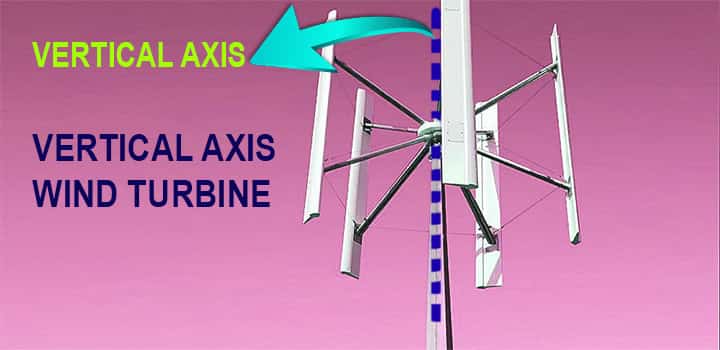
The rotation of the aerofoil is 360 degrees within the wind flow there will be high dynamic loading on the blades. Vertical axis wind turbines have difficulties installing on the tower hence they are mounted on rooftops or ground.
Obviously, there will be less wind speed so the energy generated will be lower.
There are some subtypes of the vertical axis wind turbine they are as follows.
Darrieus wind turbines
They are also known as egg-beater designs. They are named after the French inventor George Darrieus. These wind turbines require external power support to start turning.
Also, they have good efficiency but because of the large torque ripple and cyclic stresses on the tower, it results in poor reliability.
Giromill
This one is a subtype of Darrieus wind turbines but it has straight as opposed to curved blades. The Giromill has the feature of the variable pitch for reducing the torque pulsation and also it is self-starting.
There are some advantages like high starting torque, a higher coefficient of performance.
Savonius wind turbine
The savonius are drag type devices with two more scoops that are used in the anemometers. They are self-starting and have at least three scoops.
The modified version of savonius wind turbine has long helical scoops and provides smooth torque.
Advantages of VAWT
- VAWT doesn’t need to be pointed into the wind, that is advantageous in case of high changes of wind directions.
- They have low noise productions.
- VAWT can be built where tall turbines are prohibited.
- The parts like generator and gearbox can be placed on the ground which makes it easier to move and for maintenance.
Disadvantages of VAWT
- Low rotation speeds.
- Higher torque costing higher cost for drive trains.
- They are low power efficient.
- The difficulties are arising while modelling the flow accurately.
These are all the advantages of the HAWT and VAWT turbines. Wind turbines are one of the renewable sources of electricity-producing devices. There are numerous advantages of the same with few disadvantages.
Let’s see the advantages and disadvantages of wind energy developed by wind turbines.
There are so many wind turbines across the globe .
.
How Does a Wind Turbine Work?
Let’s try to understand how does wind turbine work in step by step.
Step#1 Wind Energy
The wind is flowing towards the turbine blades and it has kinetic energy. The turbine blade or hub can be adjusted with respect to the wind direction.
Due to the wind force, a lift force & drag forces are acting on the blades. Blade starts rotating due to the resultant force.
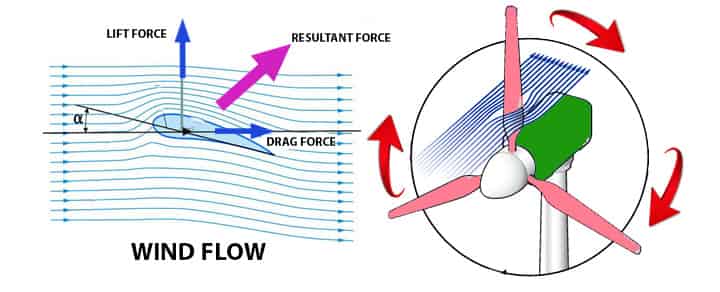
Step#2 Rotation of Rotor
Turbine blades are attached to the rotor and as the turbine blades start to rotate, the rotor will also rotate accordingly.
Step#3 Rotation of Low-Speed Shaft
The rotor is connected to a drive shaft, called a low-speed shaft. It also rotates with the rotor but the speed will less.
Step#4 Increase of turbine speed
There is a gearbox inside the nacelle where the low-speed shaft is connected to a high-speed shaft through a gear mechanism. The speed is increased here due to the high-speed ratio in the gearbox.
Step#5 Generator
High speed-shaft is connected to a generator and rotation of the shaft creates a magnetic field within the generator.
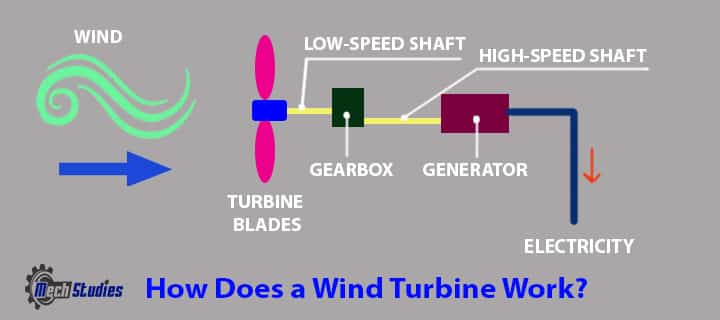
Step#6 Power Transmission
The electricity is transferred to a power grid from the generator through power cables. Power cables run within the turbine tower.
Due to this magnetic effect, electricity is produced from mechanical energy. This electricity is connected to the power grid for further consumption.
Step#7 Controls
There are many sensors to adjust the turbine direction with respect to the wind direction. The yaw mechanism helps to rotate the turbine.
Check out a NICE ANIMATED video from Learn Engineering!
There is a controller to controls as well as to stop the turbine in case the wind speed is beyond design or there is any fault. Basically, the controller helps the wind turbine to keep it safe.
Advantages of Wind Energy
Cost-effective power production
The power generated by wind turbines is cost-effective. It costs about 1-2 cents per kilowatt-hour of power usage after the tax credits. Another reason is the electricity generated from the wind farms is at fixed prices and doesn’t depend on other factors like fossil fuels in case of other power generation plants.
Reliable and infinite renewable energy
Wind power is a renewable energy source. Wind power doesn’t use any fossil fuels in need of a one-time investment and long-term returns are better considering the low environmental impacts.
Environment friendly
Wind power being a renewable power source is environment friendly. It doesn’t need any fossil fuel to power up its components. The power generation depends on the winds.
Availability in remote areas
The one-time investment can be useful for remote areas to provide electricity. In the areas where the normal power distribution is poor the wind power can act as a savior in remote areas,
Wind energy is free and can be used efficiently with modern technology.
Disadvantages of wind energy
The main disadvantages of wind energy are as follows,
- One of the main problems with wind energy is the strength of the wind. It is not constant and can go from zero to high at any time.
- Due to the variable strength of the winds, electricity production is fluctuating.
- They are noisy, the noise generated is same as that of the car running at almost 60 MPH.
- Large space and farms are needed for providing the communities enough electricity.
These are all the advantages and disadvantages of wind energy produced by wind turbines.
Actual Wind Power Calculation
We have already calculated wind energy, however, we will see the actual wind power from the wind turbine.
The wind power of wind turbine is expressed, as below,
P = (1/2) ρAV3x G.E x B.E
Where,
- P = Wind energy or wind power, watt
- ρ = Density of Air (kg/m3)
- A = Rotor Swept Area (m2)
- V = Velocity of wind (m/s)
- G.E = Generator Efficiency (%)
- B.E = Bearing Efficiency (%)
A wind turbine has a rotor of diameter 50m, it rotates at 12m/s. Calculate the wind power, if air density is 1.2 kg/m3, generator efficiency 72%, bearing efficiency 81%.
Given data
- ρ = 1.2 kg/m3
- d = diameter = 50m
- A = πd2 /4 = π x 502 /4 = 1962.5m2
- V = 12 m/s
- G.E = 72%
- B.E = 81%
Find out
Wind power P =?
Calculation
Wind Power,
- P = (1/2) ρAV3x G.E x B.E
- P = (1/2) x 1.2 x 1962.5 x 123 x 0.72 x 0.81
- P = 1186648.0 watt
- P = 1186.6 kW.
Wind Power Project Requirements
Wind power is sustainable energy and the technology is simple, however, there are a few key areas that need to study prior to set-up a wind turbine project,
- Study the climatological data.
- Study the source of wind, throughout the year.
- Study the soil characteristics for the foundation.
- Study the electricity demand and distance to the transmission line from the plant.
- The distance of the plant from the main road.
Wind Turbine Installation
The installation of the wind turbine is a very simple process, and the steps are as follows,
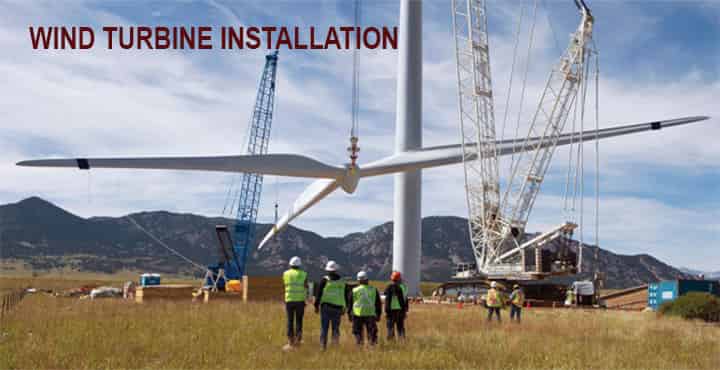
- Sizing of wind turbine,
- Selection of equipment,
- Design & construction of the foundation, to install the turbine,
- Making the trenches / trays of cables,
- Installation of turbine,
- Connect the turbine generator to a power grid,
Wind Turbine Installed Capacity
There are several wind turbines across the world, few of them are listed,
- Gansu Wind Turbine project in China, Capacity: 6800MW
- Muppandal wind turbine in India, Capacity: 1,500MW
- Alta Wind Energy Plant in USA, Capacity: 1320MW
- Jaisalmer wind turbine in India, Capacity: 1,064MW
- Brahmanvel wind project in India, Capacity: 528MW
High Rated Course
Ultimate WIND ENERGY Masterclass. Beginner to Advanced Level
Conclusion
Wind energy, as well as a wind turbine, is now being used by lots of countries also keeping in mind environmental effects. Wind energy will help to reduce the dependence on fossil fuels for power generation.
Our Apps
Check out our ‘MechStudies – The Learning App’ in iOS
& Android
Further study
Reference Articles

